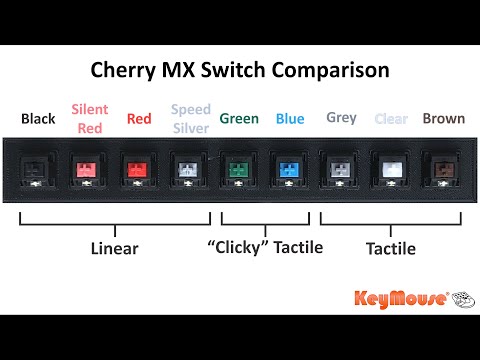Mechanical switches will sound and feel completely different when you use them individually and when you use them once you have assembled them into the keyboard. And this may lead you to have a keyboard that does not suit your needs. However, once you get an excellent mechanical switch that is suited to you, using the keyboard will feel and sound a lot better. Thus, improving your productivity and providing a great overall typing or gaming experience.This article aims to provide you with enough information about the major types of mechanical switches so that you can get a keyboard switch that is best for you.
How Does a Switch in Mechanical Keyboard Work?
Before we get into the type of switches, let us first see how a switch in a mechanical keyboard works. Once you take off the key caps, you will see a key switch. All the types of switches that a mechanical keyboard uses have an upper housing, lower housing, spring, stem and metal leaves.The steam attaches itself to a keycap. When you press a keycap, the stem is pressed against the spring. When the stem reaches a certain point, the two metal pins come in contact and register a keypress.Once you release a key, the spring pushes the stem back to its original state, and the two metal pins disconnect.
Cherry Red, Brown, and Blue Switch
You can find three types of switches that dominate the market, red, blue, and brown switches. Although you can find black, silent red, speed silver, green, gray, clear, super black, and many more, the switches are categorized depending on their working mechanism.These working mechanisms represent whether a switch is clicky, the amount of resistance and force required to activate the switch. Blue Switches are called tactile clicky, brown is tactile and red is linear. Tactile and tactile clicky switches have a visible bump on the stem. However, linear switches have smooth stems without any bumps. All the other colored switches work on the same principles as blue, brown, and red, i.e., tactile and linear.
Blue Switches (Tactile Clicky)
Keyboards with blue switches are significantly louder than the other two in comparison. Blue switches produce an audible click when pressed. This is due to an activation mechanism when you press the keycap.Blue switches have a stem composed of two components, upper stem and lower stem. These stem stay on top of one another. Once you press the upper stem with a certain actuation force, it activates the lower component. This, in turn, fully compresses the spring.This activation makes a loud and audible click sound. Due to the activation mechanism, you will feel a slight bump when the keyboard registers a keypress. Depending on personal preference, you may or may not like the distinctive clicky sound and feel of a blue switch.If you love the feel of key activation or the clicky sound, blue mechanical switches are the one for you. However, due to the slight restriction when activating the switch, the reaction time is slightly slower in these switches. Furthermore, the keyboard may be a little loud if you prefer a quieter environment.
Distinctive Feature
Brown Switches (Tactile)
Unlike blue switches, brown switches have a single component as a stem and do not produce a clicky sound. This results in the stem to have a small bump without any sound when you activate the switch.Since it is a tactile switch, the stem has a bump, and you will feel a small resistance when you activate it. This bump in the stem results in the switch giving good feedback when it activates. A Brown switch will feel like a blue switch without a clicky sound. You can use a brown switch if you want a quieter-sounding keyboard with the feel of a blue switch.However, one disadvantage to using a brown switch is that the keyboard will have a higher actuation force. And thus, resulting in slower reaction time.
Distinctive Feature
Red Switches (Linear)
Red switches do not give any feedback when you activate the switch. This is because the stem does not have any bump and the activation is one smooth movement. Due to this, you will not hear or feel the activation point. It also means a lower actuation force.Due to lower activation force, the red switches make it a lot more sensitive, and keys respond faster than blue and brown switches.Users usually prefer red switches due to their smooth stem movement. The only sound you can hear when using red switches is when the stem touches the lower casing, and when the spring pushes the stem back to its original state. If you want a quiet keyboard with low actuation force, red switches are the one for you. Due to its linear stem architecture, you will not feel any bump and thus the low actuation force. Furthermore, you can also lubricate your key switches for smooth and seamless key-press.
Distinctive Feature
Cherry Red vs Brown vs Blue – Which is Better for You?
Now that you know about the three types of key switches, let us see the difference between the three and see what is best for you.A clicky sound on your keyboard can be distracting and too loud for some users. So if you want to use your setup in a quieter environment, we recommend using a keyboard with red or brown switches or swap your keyboards switches. However, if you do not want any resistance and minimal sound when you press a key, red switches offer this exactly, a quiet switch without any bump. Blue switches are the one for you if you just want to get a feel of a mechanical keyboard without spending too much money and don’t really care about the clicky sound.







